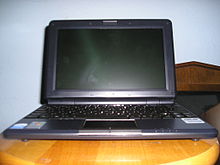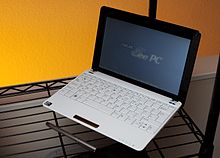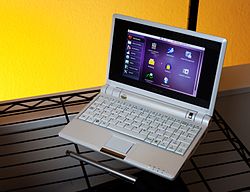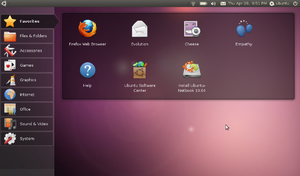- Asus Eee PC
-
Asus Eee PC 
Developer AsusTeK Computer Inc. Operating system Linux (Aurora, formerly Eeebuntu; Xandros)
Windows XP/7CPU Celeron, Atom, AMD Fusion Website eeepc.asus.com The Asus Eee PC is a subnotebook/netbook computer line from ASUSTeK Computer Incorporated, and a part of the Asus Eee product family. At the time of its introduction in late 2007, it was noted for its combination of a light weight, Linux operating system, solid-state drive (SSD), and relatively low cost. Newer models have added the options of Windows operating systems, rotary hard disk drives (HDD) and initially retailed for up to 500 euros.[1]
The first Eee PC was a milestone in the personal computer business, launching the netbook category of small, low cost laptops. According to Asus, the name Eee derives from "the three Es," an abbreviation of its advertising slogan for the device: "Easy to learn, Easy to work, Easy to play".[2]
Contents
History
Eee 700 series
Black 700 series unit side view showing the SD card reader, two USB ports, the VGA output and the Kensington Security Slot.
Asus announced two Eee PC models at Computex Taipei 2007; the Eee PC 701 and the Eee PC 1001.[3] The 701 base model Eee PC 4G was released on October 16, 2007 in Taiwan. Three additional models followed.
Both the price and the size of the device are small in comparison with similar Ultra-Mobile PCs. The Eee series is one response to the XO-1 notebook from the One Laptop per Child initiative. At the Intel Developer Forum 2007, Asus demonstrated the Classmate PC and the Eee PC, and listed specifications for four models of the Eee PC.
In some countries, the products have the marketing names EeePC 8G, 4G, 4G Surf, and 2G Surf, though in other countries the machines are still designated by the model numbers 700 and 701. The 4G Surf uses socketed RAM but some revisions do not have a door to access the slot.[4]
Asus released a version of the Eee PC with Microsoft Windows XP pre-installed in January 2008. In Japan, the version is known as the 4G-X.
Eee 900 series
The Eee 900 series was officially launched in Hong Kong on April 16, 2008, and in the UK on May 1, 2008 for £329 (approximately 410 € or 650 US$ including VAT). The system was launched in the US on May 12, 2008. The Eee 900 series dimensions are a little larger than the 70x models–measuring 225 × 165 × 35 mm (WxDxH) (8.8" × 6.5" × 1.4") and weighing around 1 kg (2.2 lb). The machine has a multi-touch trackpad that allow two-finger scrolling and zooming via a "pinch" gesture and is available with Linux (in some markets) and/or Windows XP (in some markets) configurations.
The Linux version is named the EeePC 900 and comes with a 16 GB SSD. Some of these Eee PCs also have a 4 GB SSD installed similarly to that in the 701 for a total storage space of 20 GB. Those that do not are named the Asus EEE 900 16G. The Windows XP version is named the EeePC 900 Win and also comes in two versions: one with a total storage of 12 GB (one 4 GB SSD and one 8 GB SSD) and one with 16 GB (on a single SSD). The Linux 20G version is sold for the same price as the Windows 12G version. In the case for the 16G EEEs, the Windows version costs more than the Linux version.
The Windows version comes with Microsoft Works and Windows Live Suite preinstalled. It also includes StarSuite 8. The machines are otherwise identical to each other with 1 GB of RAM, an 8.9-inch (226 mm) 1024×600 LCD and a 1.3 megapixel webcam. This model has the same Celeron CPU as the Eee PC 700, running at its full 900 MHz clock speed (rather than the 630 MHz speed seen in the Eee PC 700).
Other Eee 90x models
On June 3, 2008, Asus unveiled the Eee 901 at Computex Taipei, the 901 was a revision of the 900 series with a different chassis. The 901 features an Intel Atom Diamondville CPU clocked at 1.6 GHz, an "expanded" battery (listed as 6-cell), and "Super Hybrid Engine" software for power management which will provide a battery life of 4.2-7.8 hours. Bluetooth and 802.11n Wi-Fi are also included. The 901 uses the Intel 945GME chipset, meeting the requirements for Windows Aero for Vista or 7. The 901 is otherwise similar to the 900, shipping in Linux or Windows XP configurations which have different sizes of SSD storage. It was also discovered that the Eee 901 has capacity for a "3GCard" upgrade.[5]
The Eee PC 901 "Linux" model featuring an advertised "20 GB SSD" storage actually contains two SSD drives; one 4 GB and one 16 GB. The 4 GB drive has been reported as faster than the 16 GB drive.[citation needed]
The Eee PC 904HD was one of the first Eee PC models which features an HDD (80 GB) instead of an SSD. This model features an Intel Celeron M running at 900 MHz and gets its power from a 6-cell battery. Like other Eee PC 90x models this Eee PC also features 802.11 b/g WLAN and a 1.3M pixel webcam. Windows XP comes pre-installed.
The Eee PC 900A features almost the same specs as the Eee PC 901 (except the primary SSD, Bluetooth, 1.3M pixel webcam and the 6-cell battery, that has been replaced by a 4-cell battery) but in a case nearly the same as used in the Eee PC 900 model.
On June 17, 2009, Asus released the Disney Netpal (Eee PC MK90), which is similar to the Eee 90x models.[6]
Battery controversy
There has been some controversy regarding the battery supplied with the EeePC 900. Versions pre-released to many non UK journalists and reviewers were equipped with a 5800 mAh battery, but the first retail versions in Hong Kong, the United Kingdom and Singapore were shipped with a smaller, 4400 mAh (76% of that capacity) battery, which commentators note has led to a great variation in the machine's battery life in reviews,[7] in some cases as much as 90 minutes.[8] As a result of the objections to this, Asus provided a free battery replacement program in Hong Kong and Singapore, and ran a paid-for battery exchange program in the UK.
Asus has stated that the smaller battery is "[p]resently the standard battery supplied in the UK" and "the default standard battery pack for Asus Eee PC 900 worldwide." Asus provided a battery exchange to all UK Eee PC 900 customers for £10, and released a firmware update which claimed to extend battery life by 30 minutes ("BIOS 0601: Updated all battery discharge tables to extend battery life").
In Australia and Italy, the situation was reversed: Reviewers received EeePC 900 systems fitted with the 4400 mAh battery but the retail models were equipped with the 5800 mAh battery. Customers of Media Markt in Italy received the EeePC 900 at the beginning of sales (May/June) with a 5800 mAh battery and later (June/July) with a 4400 mAh battery.
Best Buy's custom variants of the 1000HD and 900A also both include a 4400 mAh battery.
Part of the above problem extends from the fact that the entire range were substantially more successful than Asus had originally anticipated. Currently, Asus has several large complexes scattered throughout Taiwan and China, with the largest in the city of Suzhou (China), being the size of eight football fields. Upon the unexpected success of the range, Asus factories worked around the clock to keep up supply and further development. Consequently, even within Asus testing labs in Taipei, many variations were found within test models. Generally, however, Asus does inform reviewers that the final retail model may contain different features from those offered in the review model.
Eee 1000 series
The 1000 series launched at Computex Taipei on June 3, 2008.[9] It featured a new 10-inch (254 mm) screen and a 1.6 GHz Intel Atom CPU, although built in power management software can increase the speed to 1.7 GHz. The 1000 model ships with Linux, an 8 GB SSD and a 32 GB SSD (totalling 40 GB); the 1000H model ships with Windows XP Home or Linux and an 80 or 160 GB SATA HDD. Both the 1000 and the 1000H support up to 2 GB of DDR2 RAM of 667 MHz clock speed. The 1000 has a rated battery life of 4.2–7.5 hours, while the 1000H is rated for 3.2–7 hours. It also offers a keyboard that is 92% the size of generic notebooks, aiming to make it more comfortable to type. Like the Eee PC 901, the new machines feature 802.11n Wi-Fi and Bluetooth. WiMAX is not currently supported.
The 1000HD (released in September 2008) is a slightly cheaper version of the 1000 series. It features the same specifications as the 1000H, except it uses a 900 MHz Celeron CPU chip.
The 1000HA (released in October 2008) also costs less than the 1000H, but has the same Intel Atom 1.6 GHz CPU, a 160 GB HDD, and 1 GB of RAM. It also has wireless and some models present Bluetooth.
The 1000XPH has the same Intel Atom 1.6 GHz CPU, an only 80 GB HDD, and 1 GB of RAM. Other amenities include a 10/100 LAN and 802.11 b/g Wireless LAN adapters, an integrated webcam, but no Bluetooth.In February 2009, Asus unveiled the 1000HE, using the new Intel Atom 280 processor with a 10-inch LED-lit display, 6-cell battery, 160 GB HDD, Bluetooth, 802.11n wireless networking, 1.3 megapixel camera, and a revised keyboard.
At CeBIT 2009, Asus unveiled the 10-inch EEE 1008HA, introducing the new design concept "Seashell".[10]
The 1005HA comes in three models, from least-to-most expensive, they are the 1005HA-B, the 1005HA-V and the 1005HA-P. The 1005HA-B has a removable 3-cell battery with a rated 4-hour life per charge, a 1.3 megapixel camera, and uses the N270 processor. At the higher end, the 1005HA-P has a removable 6-cell, 5600 mAh, 63 W/h battery with rated 10.5 hour battery life, a 1.3 megapixel camera and uses the N280 processor. There is also a 1005HA-H model, sold in Poland, equipped with a 6-cell battery, an N270 processor and a 0.3 megapixel camera.[11]
Asus officially announced the first Eee with Nvidia ION graphics, the 1201N, on November 19, 2009, later replaced by the 1201PN and then 1215N, with a more powerful Atom D525 dual-core processor and ION2 graphics.
The 1215 series then saw the release of the 1215B,[12] which came with the AMD E-350 processor, a "Zacate" APU. As the 1215b has usb3 and a cpu and bios that supports full hardware virtualization in linux via (kvm or xen) or Windows via (XP mode, Virtual Box, Vmware). The 1215b was the 1st eee pc able to do 64 bit and virtualization.
Technical overview
Processor
Eee PC models have typically used netbook specific processors or ultra-low voltage versions of mainstream processors. The earliest Eee PC models used a 900 MHz Intel Celeron M processor underclocked to 630 MHz. Later models shipped with Intel Atom and AMD Fusion processors.
Display
The Eee PC 700 has a 800×480 pixels 7 inch (178 mm) display, measured diagonally. The screen does not cover the entire space within the lid; instead it is flanked on the sides by stereo speakers and, above, by the (optional) camera in the trim at the top. The Eee PC 900 and 901 come with a 1024x600 pixels 8.9-inch (226 mm) display, almost filling the lid.
Later models came with 10 inch to 12.1 inch displays and up to 1366x768 resolution.
With all models, an external display can be supported through a standard VGA connector. The manufacturer does not give any specifications on maximum resolution and display configuration (mirroring, extended desktop), but most models can handle an external display at native resolution of 1440 x 1050, and even 1600 x 900 although performance starts to slow down. Models that ship with Xandros do not have access to the full capacity of the external VGA output by default, allowing only 'mirroring'. Users must reconfigure their xorg.conf file, or install a more feature-rich OS such as Eeebuntu to allow the higher resolution output.
Keyboard
On a normal, "full size" computer keyboard, the 10 keys Q–P measure 190 mm (7.48 in). The 700 and 900 series are equipped with similar keyboards, 82 % size of a generic one, meaning that the Q–P keys measure 155 mm (6.10 in). The 1000 series, as it fits in a more spacious case, has 92 % of a full size keyboard, where the Q–P keys measure 175 mm (6.89 in).
Some Eee PC lines such as the 1000HE and 1215s uses the island-style keyboard, similar to keyboards used in Apple computers and Sony's VAIO series, where the keys are reminiscent of Scrabble tiles, being spaced apart and raised from the surface below.
Storage
The early model Eee PCs use a solid-state drive for storage (instead of a hard drive), which consumes less power when in use, allows the device to boot faster, generates no noise, and is less susceptible to mechanical shock damage than hard drives. A down side of SSD storage (flash memory) is that an individual sector can be written only about 100,000 times. This problem can be partially mitigated by intelligent wear leveling, resulting in a MTBF similar to conventional platter-based hard drives.
The SSDs used in early Eee PCs also had extremely poor random write performance (the S101 does not have this problem).[13]
In the 2 GB and 4 GB models of the 700 series of the Eee PC, the SSD is permanently soldered to the board. In the 8 GB model, the SSD is a card connected via the internal PCI Express Mini Card connector, leaving the original SSD area on the motherboard empty.
The Eee PC 900 comes with a removable PCI Express Mini SSD module, with or without four additional 1 GB memory chips soldered on the main board. Different models come with different-sized SSDs. One Linux version has 4 GB, a Windows XP version has 8 GB, and all remaining ones (Windows XP or Linux) have 16 GB.
The Eee PC 1000 contains a fast 8 GB internal SSD and a slower 32 GB internal flash drive.[citation needed]
Some models, such as the 1000H and 904HD do not have a SSD, and instead have a SATA internal hard drive of either 80- or 160 GB, which can be upgraded by the user.
All Eee PC models also include a memory card reader, supporting SD, SDHC and MMC cards for additional storage while the Eee PC S101 also has support for Memorystick and MS-PRO.
Eee PC 1004DN is the first model with a Super-Multi optical disc drive (ODD) that reads and writes data to DVD or Compact Disc.
Memory
Most early EEE PCs use 533/667 MHz DDR2 SDRAM via a standard SO-DIMM module, which can be swapped out. The 700 and 701SDX have RAM soldered to the motherboard. Other models (like the white 4GS-W010) had lacked memory access panels and required disassembly to upgrade memory.[14]
Later models, such as the black model EEEPC 4G SURF (4GS-PK008), and newer white models (4GS-W010) have a removable panel on their underside that allows the user to change the RAM without fully disassembling the system.
Cooling
In an EE380 talk[15] (video archive), an Asus engineer mentioned that the Eee PC uses the keyboard shielding as a heat sink to absorb the heat generated by the processor. The Eee PC has a fan, and some vents to also cool off the system.
Compatible operating systems
As the Eee PC uses a standard x86 processor, most operating systems can be installed with little effort, though full hardware support varies, especially for the latest models.
The following operating systems are known to work on certain models:
- Microsoft Windows[16][17]
- GNU/Linux, BSD, Solaris, Joli OS, MeeGo, Android,[18] and other Unix-like systems[19][20]
- Mac OS X v10.4[21][22]
- Mac OS X v10.5[22][23]
- Mac OS X v10.6[22][24]
- Syllable[25]
- Haiku, development releases
Linux on the Eee PC
Xandros
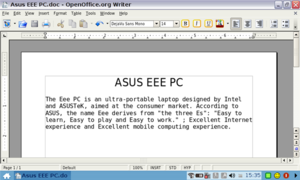 OpenOffice.org Writer running on the Eee PC
OpenOffice.org Writer running on the Eee PC
Xandros, a Linux distribution, boots in 20–22 seconds on the Eee PC, substantially faster than the boot time for an installation of Windows XP on the same hardware.[26] Xandros on the Eee PC runs a custom tab-based interface, uses IceWM as the default window manager, and comes with forty bundled software applications including OpenOffice.org, Mozilla Firefox, Skype, Tux Paint and other educational entertainment software, e-mail and Internet radio applications, and look-up tools for Google Docs and Wikipedia.
The operating system drivers for the ACPI and wireless devices supplied with the pre-installed Xandros operating system are versions of software licensed under the GNU General Public License. The company released the source code as a ZIP file along with the product; however, it has been reported that a small percentage of the source may be missing, and some device driver software appears obfuscated.[27] In the absence of necessary source code, other Linux kernel versions and distributions on the device are less easy to use with some of the hardware. Asus has since released the source code for the ACPI module. They have also released the patched Linux kernel sources and their Busybox sources. The Synaptic Package Manager and apt-get can be used to install additional software through the repositories.
Forks and other distributions
Current Asus Linux development policy generates forks of code as they change. This means that their changes do not go directly into upstream versions and remain available only through Asus source code releases. If one wants to change to another distribution or update the software, it is necessary to determine what has been changed (using, for example, the diff utility) and port into a newer version or other distribution. For example, the Eee PC 900 model has a sound card that needed some modifications to the Linux kernel driver to work. Asus' modifications were against version 2.6.21.4 from June 2007. This problem was removed with the kernel 2.6.28 and above.[citation needed]
Specifications
Eee PC models[28] Component 700 (2G Surf) 701 (4G Surf) 701 (4G)[I] 701SD 702 8G 900 900 16G 900SD 900HD 900A 901 MK90H 904HD 1000HD 1000H 1000HA 1000 1002HA 1000HE 1005HA-P 1008HA 1101HA 1201HA 1201N 1215b Display Diagonal 7 in (17.8 cm) 8.9 in (22.6 cm) 10.2 in (25.9 cm) 11.6 in (29.5 cm) 12.1 in (30.7 cm) Resolution (px×px) 800×480 (WVGA) 1024×600 (WSVGA) 1366×768 (WXGA) Type TFT LCD with LED backlight TFT LCD Storage SSD soldered (GiB) 2 4 4 8 8 or 4 (US) or 0 (US/DE) 4 (removable) 8 (removable) SSD removable (GiB) 8 8 (Windows XP) or 16 (Linux) 16 Only insertable if WLAN removed 16 or 8 (DE), 0 (US), or 4 (US) 8 (Windows XP) or 16 (Windows XP/Linux) 32 HDD (GB) 30 external in some markets 160 160 80[9] 80 or 160 160 160 250 / 320 CPU Model Intel Celeron-M ULV 353 Intel Atom N270 (45 nm Diamondville, Socket 437 FCBG8A) Intel Celeron-M ULV 353 Intel Atom N270 (45 nm Diamondville, Socket 437 FCBG8A)[9] Intel Atom N280 (45 nm Diamondville, Socket 437 FCBG8A) Intel Atom Z520 Intel Atom N330 C-50 or E-350 Frequency (GHz) 0.8 @ 0.571; 32 kB L1 cache 0.9 @ 0.63 (70 MHz × 9) 0.9 1.6 0.9 @ 0.63 (70 MHz × 9) 1.6 1.66 1.33 1.6 1.0 or 1.6 Cache 512 kB L2 cache RAM, 8-way set associative, 64-byte line size 2 × 512 kB L2 cache RAM Memory (GiB) Default amount 0.5 0.5 1 1 (Windows XP), 1 or 2 (Linux) 1 1 (Windows XP), 1 or 2 (Linux) 1 1 2 and type DDR2-400 onboard[citation needed] DDR2-533/667 DDR2-400, supports 533/667 DDR2-400, supports 533/667 DDR2-400, supports 533/667 DDR2-533/667 DDR2-667/800 DDR3-1333 Sockets (max. upgrade) soldered RAM 1 (2 GiB) Not upgradeable 1 (2 GiB) 1 (4 GiB) 2 (4 GiB) 2 (8 Gib) Graphics Integrated GMA 900 (SMA),
VGA port (up to 1600×1280 pixels)Integrated GMA 950 Integrated GMA 900 Integrated GMA 950 Integrated GMA 500 Nvidia Ion Integrated Radeon HD 6250 GPU Chipset Intel 910GML Intel 915GM/GMS, 910GML Express Intel 945GSE Intel 910GML + ICH6M Intel 945GSE + ICH7M Intel 945GSE + ICH7M Intel Poulsbo US15W Nvidia Ion Fusion_Controller Battery Cells 4 6 4 6 2 6 4 6 Capacity (Ah) 4.4 4.4 or 5.2 4.4 4.4 or 5.8 6.6 6.6 4.2 8.7 Voltage (V) 7.4 7.4 7.4 7.4 or 7.2 7.4 7.4 7.4 Approx. run time (h:m) 2:45 Unknown or 3:30 No info or 3:30 4:15–7:45 4:15–7:45 5:00 9:30 Type Li-ion Li-ion Lithium-polymer Camera (Mpx) No 0.3; up to 640×480, up to 30 frame/s 1.3 0.3 0.3 0.3, or none 1.3 1.3 0.3 or 1.3 (on HA models) 1.3 0.3 Size (mm) Width 225 248 265.9 264 266 Depth 165 170 175.3 173 191.3 181 191.2 Height ~21–35 ~20–38 22.9 ca 24-28.7 38.1 27.6 ca 28.5-38 Weight (g) 922 990 1,140 1,100 1,400 1,450 1,330 1,200 1,450 1,460 Network adapters LAN (Mbit/s) 10/100 (Attansic L2) 10/100 10/100/1000 WiFi (802.11) b/g mini PCI-E card (Atheros- or Ralink-based). b/g/n mini PCI-E card
Eee PC 901/1000: Ralink RT2860.b/g/n Bluetooth No Yes No Yes No Yes Yes OS Linux Xandros[II] running KDE and IceWM No Xandros[II] No Xandros[II] No Yes No Yes Windows XP Yes Windows 7 No Yes Other Audio Realtek ALC662 Hi-Definition Audio 5.1 codec; built-in stereo speakers; built-in microphone Connectors 3 × USB 2.0 ports, MMC/SD (HC) card reader, Ethernet port, modem port (non-functional, empty), microphone input, headphone jack, AC power jack, VGA out, Kensington lock slot. Colors Pearl white (pure white for Surf models) or galaxy black; lush green, sky blue, blush pink (spring 2008) Expansion 2 × PCI Express Mini Card connectors: 1 occupied by the wireless network card; 1 empty, accessible on some models from opening on back of unit, which supports only Asus-approved SSD expansion units. The second PCIE connection is unavailable on many current-generation Eee PCs and some older models. - ^I. In the UK, the Eee is also promoted as the RM Asus Minibook, which is targeted at students; however, the unit itself is no different.
- ^II. 701 4G (non-Surf) late releases have Windows XP pre-installed without Microsoft Works and Windows Live Suite, excluding the disc, or either Xandros OS pre-installed.[citation needed]
Configurations
Naming of the 700 series of models of the device appears to relate to the size of installed SSD, camera, and battery size. The Eee PC Surf models include the 4400 mAh battery pack and no webcam, while the non-Surf models have the 5200 mAh battery pack and a webcam installed. The model numbers (700, 701) may still be the same as has been seen on pre-production samples. Asus may offer upgrades for the SSD storage via the empty Mini PCIe slot, which has been shown to be labeled FLASH_CON in take apart photos of the 4G. When a Mini PCIe card is inserted into the spare empty slot, the internal SSD gets disabled, making the device unable to boot from the original SSD.[29] There are also signal lines for a USB port on the Mini PCIe pins which have been used to connect various USB devices internally. Some 701 models with serial numbers starting at 7B do not have a second mini PCIe slot soldered onto the motherboard, though the circuit traces and solder pads remain.[30]
A controversy over a "warranty void if removed" sticker on the RAM access cover panel prompted Asus to release a statement clarifying the matter, stating that "merely breaking or removing this kind of seal will not void the Asus Limited Warranty" (emphasis is original). Since then, Asus has offered to replace the labels with ones specifying merely that Asus will not be held "responsible for the damage caused by improper hardware change." Furthermore, Asus altered their Limited Warranty to "eliminate any provision stating that the Asus Limited Warranty will be voided simply because the product is serviced by a non-Asus-approved service facility, or if non-Asus-approved components or software are installed or used."
In the 70x series, the pre-installed Xandros operating system has a Linux kernel with a kernel option set limiting the detected RAM size to a maximum of 1 GB, even if a larger RAM module is installed. The actual capacity is shown in full in the BIOS setup and under other OSes. However it is possible to recompile the kernel with support for more RAM. The 900 and later laptops had the kernel pre-configured to support up to 4 GB of memory address space.
Popularity
Sales
Asus shipped 700,000 Eee PCs in September 2008 and total shipments reached 1.7 million in the third quarter of 2008
See also
- ASUS Eee
- ASUS EeeBox PC
- ASUS Eee Top
- Comparison of netbooks
- Comparison of netbook-oriented Linux distributions
- Comparison of subnotebooks
- Internet appliance
References
- ^ "Asus Eee PC 1215 Series - Notebookcheck.net". http://www.notebookcheck.net/Asus-Eee-PC-1215N-Series.37190.0.html. Retrieved 27 September 2011.
- ^ "Asus Eee PC". Asus. 2008. http://eeepc.asus.com/global/. Retrieved 2008-04-10.
- ^ "Asus unveils ultra-low-cost Linux laptop". LinuxDevices.com. 2007-06-06. http://www.linuxdevices.com/news/NS9292516116.html. Retrieved 2007-07-11.
- ^ "Asus Eee Surf memory upgrade". http://www.flickr.com/photos/9048848@N05/sets/72157603434112782/detail/.
- ^ Published on 17th June 2008 by Richard Swinburne (2008-06-17). "Asus Eee PC 901 Dissected". Bit-tech.net. http://www.bit-tech.net/hardware/2008/06/17/inside-the-eeepc-901-investigating-atom/1. Retrieved 2010-09-04.
- ^ "ASUS inexplicably releases a Disney netbook". 16 June 2009. http://techcrunch.com/2009/06/16/asus-inexplicably-releases-a-disney-netbook/. Retrieved 19 November 2011.
- ^ "Eee PC 900 owners find weaker batteries than those used by reviewers – Engadget". Engadget.com. http://www.engadget.com/2008/04/22/eee-pc-900-owners-complain-of-weaker-battery-than-used-in-review/. Retrieved 2010-09-04.
- ^ "Asus Eee PC 900 Full Review, Laptop Reviews on CNET.co.uk". Reviews.cnet.co.uk. http://reviews.cnet.co.uk/laptops/0,39030092,49296523,00.htm. Retrieved 2010-09-04.
- ^ a b c "Asus announces 10in, HDD-equipped Eee PC". http://www.reghardware.co.uk/2008/06/03/asus_eee_1000/.
- ^ Müssig, Florian (2009-03-03). "Eee-PC-Parade" (in German). c't (Germany: Heise.de). http://www.heise.de/newsticker/Eee-PC-Parade--/meldung/133895. Retrieved 2011-10-14.
- ^ "ASUS Eee PC™ Comparison List". event.asus.com. http://event.asus.com/eeepc/comparison/eeepc_comparison.htm. Retrieved 2010-08-23.
- ^ http://www.netbooklive.com/asus-eee-pc-1215b-review-8726/
- ^ "ASUS EEE S101 SSD performance – not too shabby netbook". http://gadgetmix.com/netbook/asus-eee-s101-ssd-performance-not-too-shabby-netbook/.
- ^ "Asus EEEPC Tips and Tricks:Hardware". Serban Ghita. 2008-01-02. http://www.serbanghita.com/install-windows-xp-on-asus-eeepc.html#s6. Retrieved 2008-01-03.
- ^ "The Next Big Thing—The Challenges of Producing Small Form Factors: The Asus Eee PC". Stanford University. 2008-05-14. http://www.stanford.edu/class/ee380/Abstracts/080514.html. Retrieved 2008-05-15.
- ^ "Installing Windows XP on Asus Eee PC". EeeGuides. 2007-11-29. http://www.eeeguides.com/2007/11/installing-windows-xp-from-usb-thumb.html. Retrieved 2007-11-29.
- ^ "Installing Windows Vista on Asus Eee PC". EeeGuides. 2007-12-01. http://www.eeeguides.com/2007/12/installing-windows-vista-on-asus-eeepc.html. Retrieved 2007-12-01.
- ^ "Building Android for the Asus Eee PC 701". Androidx86.org. 2009-01-18. http://www.androidx86.org/component/content/article/35-building/46-building-android-for-the-asus-eee-pc-701.html. Retrieved 2010-08-23.
- ^ "Ubuntu Netbook Edition Hardware Support". https://wiki.ubuntu.com/HardwareSupport/Machines/Netbooks. Retrieved 2010-05-02.
- ^ "NetBSD on Netbooks". TNF. http://www.NetBSD.org/ports/i386/netbook.html.
- ^ "How to run Mac OS X 10.4 Tiger on the Asus EeePC". Tangient LLC. http://tigeroneee.wikispaces.com/. Retrieved 2010-08-23.
- ^ a b c Running this system, Eee PC is known as a Hackintosh.
- ^ "How to Install Mac OS X 5.5 Leopard on the Asus EeePc 1000h". http://www.enik.ch/2008/10/osx-leopard-1055-on-the-eee-1000h/.
- ^ "How to Install Mac OS X 10.6 Snow Leopard on the Asus EeePc 1000h". http://www.enik.ch/2009/10/osx-10-6-1-snowleopard-on-the-eee-1000he-part-1/.
- ^ Holwerda, Thom (2008-04-14). "Syllable Runs on the Asus Eee PC". OSNews. http://osnews.com/story/19630/Syllable_Runs_on_the_Asus_Eee_PC. Retrieved 2008-05-16.
- ^ "Linux Eee PC Far Faster Than Windows Version". Linuxloop.com. 2008-04-21. http://www.linuxloop.com/news/2008/04/21/linux-eee-pc-far-faster-than-windows-version/. Retrieved 2010-09-04.
- ^ Biffle, Cliff (2007-11-22). "Asus eeePC: First impressions and GPL violations". http://cliffhacks.blogspot.com/2007/11/asus-eeepc-first-impressions-and-gpl.html. Retrieved 2007-11-25.
- ^ "Asus Eee PC Comparison List". Event.asus.com. http://event.asus.com/eeepc/comparison/eeepc_comparison.htm. Retrieved 2010-09-04.
- ^ "Modding the Asus 701 (Eee)". WordPress. 2007-11-20. http://tnkgrl.wordpress.com/2007/11/20/modding-the-asus-701-eee/. Retrieved 2007-11-20.
- ^ "It’s True: New Batch of Eee PC’s Missing Mini-PCIe Connector". EeeUser.com. 2007-12-02. http://www.eeeuser.com/2007/12/02/its-true-new-batch-of-eee-pcs-missing-mini-pcie-connector/. Retrieved 2007-12-03.
External links
ASUS Eee FamilyASUS Eee PC · ASUS Eee Box · ASUS Eee Keyboard · ASUS Eee Stick · ASUS Eee Top · ASUS Eee Pad Transformer · ASUS Eee ReaderNetbooks - Acer Aspire One
- Asus Eee PC
- Classmate PC
- CloudBook
- Dell Inspiron Mini
- Doel
- ECS G10IL
- Elonex ONE
- Gdium
- Gigabyte M912
- HP Mini 1000/Mini-Note
- IdeaPad
- MSI Wind
- Nanobook
- Noahpad
- OLPC XO-1
- One A110
- Samsung N130/N140 NC10/NC20
- Skytone Alpha-400
- Sony VAIO M series
- Sony VAIO W series
- Tianhua GX-1C
- VIA OpenBook
- Comparison of netbooks
- Netbook manufacturers
- Comparison of netbook-oriented Linux distributions
Linux-powered devices Computers
Components- Asus Routers
- BT Home Hub
- Buffalo AirStation
- Junxion Box
- Linksys WRT54G series
- Netgear FVS336G
- Netgear DG834G
- Picotux
- Killer NIC
Other- Chumby
- Gumstix
- Palm Foleo
- Beagle Board
- Stanley
- SheevaPlug
- Pandora

Accessories - DBox2
- Dreambox
- Hauppauge MediaMVP
- Neuros OSD
- TiVo
- Vu+
- Wizpy
- Roku Digital Video Player
ConsolesDefunct/Historical Categories:- Asustek products
- Subnotebooks
- 2007 introductions
Wikimedia Foundation. 2010.



